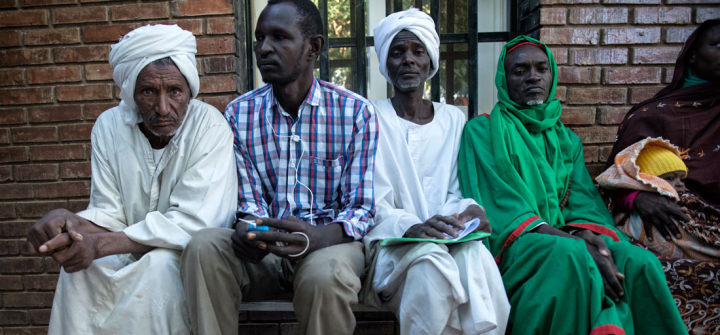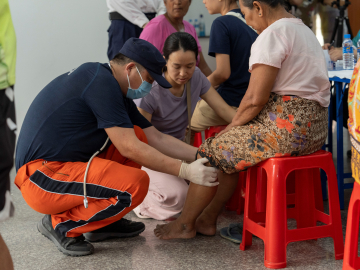Who Will Champion Mycetoma?
This disease caused by flesh- and bone-destroying fungi afflicts unknown thousands of people, yet research funding is virtually nonexistent. It’s time for the global health community to jumpstart research and bring hope to victims.
If some diseases are silent killers, bringing subtle symptoms that go undetected for months or years, then mycetoma announces itself with a putrid tumor that tortures its victims for the rest of their lives.
The disease begins when a microscopic fungal spore passes through a prick or cut on the victim’s skin, usually on the hands or feet. The initial wound can heal within a few weeks, but the fungal spores remain in tissue, leading to intense inflammation. Over time, a grotesque mass develops, often growing to the size of an orange or a grapefruit with draining sores that discharge pus. Eventually, the fungal mass eats away at the patient’s tissue and bones. The growths combine with lesions, sores, pus and odors to make mycetoma a horrifically disfiguring disease. Doctors are forced to amputate arms and legs in the most severe cases.
Yet this horrific disease that afflicts its victims so prominently is largely invisible to the the international community. With few statistics on its prevalence in the 23 countries in the so-called “mycetoma belt” that stretches from India to Sudan to Mexico, no philanthropies or governments have come forward to champion this disease the way the Bill and Melinda Gates Foundation has for malaria and The END Fund has for trachoma and river blindness.
Mycetoma needs global champions because when we neglect it, we are neglecting the urgent health needs of some of the world’s most vulnerable people. Without research, we can’t quantify the disease’s impact. Nor can we adequately fight the disease. Lacking good knowledge about how to prevent and control mycetoma, countries do not have national programs to deal with the disease, and clinicians have no easy way to cure it.
Now, finally, the world has the opportunity to bring this debilitating disease into the spotlight when the World Health Assembly, meeting next week in Geneva, finally votes on whether or not to add mycetoma to the World Health Organization’s list of 17 neglected tropical diseases—a seemingly small bureaucratic step that is actually essential to expanding research on mycetoma.
Assembly members should not squander the opportunity to bring hope to mycetoma’s victims.
Mycetoma’s most avid champion has been Ahmed H. Fahal, a Sudanese surgeon and director of the Mycetoma Research Center in Khartoum. He’s lobbied for years to get mycetoma on the WHO’s list, because donors such as the Gates Foundation look to the list for their funding decisions. However, earlier this year the US argued for a systematic approach to the list, which would have delayed the vote on including mycetoma. In this regard, some worry that if the list grows too long it may become nothing more than a catalog of underfunded diseases.
But that view fails to take into account the profound impact new research and attention would have for those suffering from this long-neglected disease.
Documented since the 19th century, mycetoma is a disease of poverty, most likely to afflict poor villagers, migrants and agricultural workers—people so impoverished they lack shoes or work gloves. Mycetoma can be treated effectively in the early stages with antifungal drugs but these therapies are usually unavailable and/or unaffordable for the very poor. The pricey drug treatments have to be taken for an extended period time to see any type of results. Once the disease takes hold the fungus is very difficult to clear even after years of antifungal therapy. So families must pool their money to help victims afford costly medicines, but often they can’t continue taking them as long as necessary and the result is amputation and with loss of limb there is loss of livelihood.
How prevalent is this problem? Though we don’t know for sure, mycetoma is believed to be widespread in some of the world’s most impoverished places. In 2014, a field study conducted in Sudan’s White Nile State found mycetoma afflicted 14.5 out of 1,000 people. And well-funded studies are likely to uncover document a much wider impact.
“We feel very strongly that mycetoma’s burden is underestimated,” Nathalie Strub Wourgaft, medical director at the Drugs for Neglected Disease initiative based in Geneva, Switzerland, told the Johns Hopkins Bloomberg School of Public Health’s Global Health NOW website last year.
Numbers aren’t enough to describe the cost of a disease, of course. Think of this: Fahal has had to amputate a limb every month or so from patients whose bones had been destroyed by the fungus. Among his patients are lives destroyed—a young man who had to abandon his dream of graduating from college, a woman who can no longer walk distances or carry heavy things because it’s too painful.
Could steps as simple as providing shoes to people in places where mycetoma is common or clearing thorny bushes help eliminate the disease? We don’t even know that much, given the sparse research done so far.
“Until someone in the United States or Europe gets mycetoma, no one will pay attention,” Fahal told Global Health NOW.
It would be a grave shame to wait for that to happen.
Arturo Casadevall, MD, PhD, is a Bloomberg Distinguished Professor and chair of the W. Harry Feinstone Department of Molecular Microbiology & Immunology at the Johns Hopkins Bloomberg School of Public Health and an expert in fungal diseases.
Ed. Note: Read Amy Maxmen’s GHN series on mycetoma in Sudan here.
Join the thousands of subscribers who rely on Global Health NOW summaries and exclusive articles for the latest public health news. Sign up for our free weekday enewsletter, and please share the link with friends and colleagues: Subscribe to GHN




